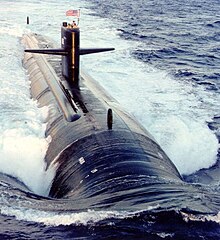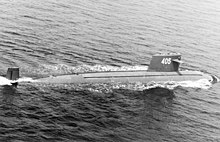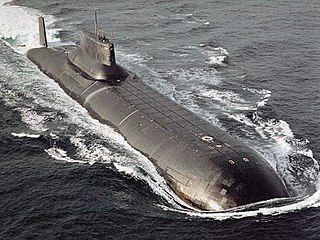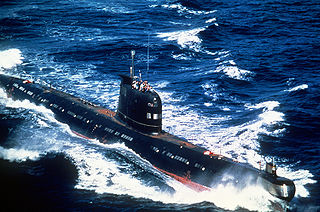
The following countries operate or have operated submarines for naval or other military purposes.

The following countries operate or have operated submarines for naval or other military purposes.





Ballistic missile submarines are larger than any other type of submarine, in order to accommodate ballistic missiles capable of carrying nuclear warheads.

A submarine-launched ballistic missile (SLBM) is a ballistic missile capable of being launched from submarines. Modern variants usually deliver multiple independently targetable reentry vehicles (MIRVs), each of which carries a nuclear warhead and allows a single launched missile to strike several targets. Submarine-launched ballistic missiles operate in a different way from submarine-launched cruise missiles.

A corvette is a small warship. It is traditionally the smallest class of vessel considered to be a proper warship. The warship class above the corvette is that of the frigate, while the class below was historically that of the sloop-of-war.

A ballistic missile submarine is a submarine capable of deploying submarine-launched ballistic missiles (SLBMs) with nuclear warheads. The United States Navy's hull classification symbols for ballistic missile submarines are SSB and SSBN – the SS denotes submarine, the B denotes ballistic missile, and the N denotes that the submarine is nuclear powered. These submarines became a major weapon system in the Cold War because of their nuclear deterrence capability. They can fire missiles thousands of kilometers from their targets, and acoustic quieting makes them difficult to detect, thus making them a survivable deterrent in the event of a first strike and a key element of the mutual assured destruction policy of nuclear deterrence.

An attack submarine or hunter-killer submarine is a submarine specifically designed for the purpose of attacking and sinking other submarines, surface combatants and merchant vessels. In the Soviet and Russian navies they were and are called "multi-purpose submarines". They are also used to protect friendly surface combatants and missile submarines. Some attack subs are also armed with cruise missiles, increasing the scope of their potential missions to include land targets.

The R-39 Rif was a submarine-launched ballistic missile (SLBM) that served with the Soviet Navy from its introduction in 1983 until 1991, after which it served with the Russian Navy until 2004. The missile had GRAU indices of 3M65, 3M20, and 3R65. It was carried on board Typhoon-class submarines.

The Typhoon class, Soviet designation Project 941 Akula, is a class of nuclear-powered ballistic missile submarines designed and built by the Soviet Union for the Soviet Navy. With a submerged displacement of 48,000 tonnes, the Typhoons are the largest submarines ever built, able to accommodate comfortable living facilities for the crew of 160 when submerged for months on end. The source of the NATO reporting name remains unclear, although it is often claimed to be related to the use of the word "typhoon" ("тайфун") by General Secretary Leonid Brezhnev of the Communist Party in a 1974 speech while describing a new type of nuclear ballistic missile submarine, as a reaction to the United States Navy's new Ohio-class submarine.

Project 629, also known by the NATO reporting name Golf, was a class of diesel-electric ballistic missile submarines that served in the Soviet Navy. All boats of this class had left Soviet service by 1990, and have since been disposed of. According to some sources, at least one Golf-class submarine was operated by China, to test new submarine-launched ballistic missiles (SLBMs).

Whiskey-class submarines are a class of diesel-electric attack submarines that the Soviet Union built in the early Cold War period.

The Project 633 class is a class of Soviet diesel-electric submarine, built between 1957 and 1961. A Chinese variant, Type 033, was built in China from 1962 to 1984.

The Foxtrot class was the NATO reporting name of a class of diesel-electric patrol submarines that were built in the Soviet Union. The Soviet designation of this class was Project 641. The Foxtrot class was designed to replace the earlier Zulu class, which suffered from structural weaknesses and harmonic vibration problems that limited its operational depth and submerged speed. The first Foxtrot keel was laid down in 1957 and commissioned in 1958 and the last was completed in 1983. A total of 58 were built for the Soviet Navy at the Sudomekh division of the Admiralty Shipyard, Saint Petersburg. Additional hulls were built for other countries.

The Delta class, Soviet designations Project 667B Murena, Project 667BD Murena-M, Project 667BDR Kalmar, Project 667BDRM Delfin, are a series of nuclear-powered ballistic missile submarines, designed and built in the Soviet Union, which formed the backbone of the Soviet and Russian strategic submarine fleet since their introduction in 1973. They carry nuclear ballistic missiles of the R-29 Vysota family, with the Delta I, Delta II, Delta III and Delta IV classes carrying the R-29, R-29D, R-29R and R-29RM respectively. The Delta I class carried 12 missiles, while the Delta II class which are lengthened versions of the Delta I class carry 16 missiles. The Delta III and Delta IV classes carry 16 missiles with multiple warheads and have improved electronics and noise reduction.

Dmitriy Donskoy is a Russian Navy nuclear ballistic missile submarine, designated Project 941 Akula class.

The P-5 "Pyatyorka", also known by the NATO codename SS-N-3C Shaddock, is a Cold War era turbojet-powered cruise missile of the Soviet Union, designed by the Chelomey design bureau. The missile entered service in 1959. Pyatyorka is a common name for the missile as the "digit 5", corresponding to the R-7 Semyorka, the digit 7.

The Project 205 Moskit (mosquito) more commonly known by their NATO reporting name Osa, are a class of missile boats developed for the Soviet Navy in the late 1950s. Until 1962 this was classified as a large torpedo boat.

Novorossiysk was a conventionally powered aircraft carrier that served the Soviet Navy and the Russian Navy from 1982 to 1993. She was the third Kiev-class vessel to be built. She was designed to engage in offensive actions as a guided missile cruiser mostly using her deck mounted missiles as well as support anti-submarine and surface actions with her embarked air group.

Bditel'nyy or Bditelnyy was a Project 1135 Burevestnik Large Anti-Submarine Ship or Krivak-class frigate that served with the Soviet and Russian Navies. Launched on 28 March 1970, the vessel served as part of the Baltic Fleet but operated more widely than the Baltic Sea, demonstrating the emerging blue water capability of the Navy. A dedicated anti-submarine vessel, with an armament built around the Metel system, the ship spent the period between 26 December 1970 and 30 September 1971 undertaking trials and tests to prove the new systems. During that time General Secretary Leonid Brezhnev and Admiral of the Fleet Sergey Gorshkov were both hosted on board. The vessel then subsequently undertook tracking of submarines in the Baltic, Black and Mediterranean Seas, and even travelled as far as Cuba, crossing the Atlantic Ocean. The ship also visited friendly ports like Annaba in Algeria, Gdynia in Poland and Rostock in East Germany. With the end of the Cold War, the ship also travelled to Belgium and visited Antwerp. During June 1993, Bditelnyy took part in BALTOPS-93, the first joint exercise between NATO and Russia. However, soon afterwards, the ship was retired and, on 31 July 1996, decommissioned and subsequently broken up.

Zadornyy was a Project 1135 Burevestnik-class guard ship or Krivak-class frigate that served with the Soviet and Russian Navies. Displacing 3,200 tonnes full load, the vessel was built around the Metel anti-submarine missile system. Zadornyy was launched on 25 March 1979 in Leningrad, the last of the class to be built by the A.A. Zhdanov shipyard, and served with the Northern Fleet. After taking part in exercises Avangard-81, Sever-81 and Okean-83, and cruising as far as Havana, Cuba, the vessel was upgraded between 11 June 1990 and 23 May 1995 with missiles that added anti-ship capability. While serving with the Russian Navy, the ship took part in joint exercises with frigates of the Royal Navy, including a commemoration of the first Arctic convoy of the Second World War with HMS Campbeltown. After more than twenty-five years service, the ship was decommissioned on 3 December 2005.

The Cuban Revolutionary Navy is the navy of Cuba.